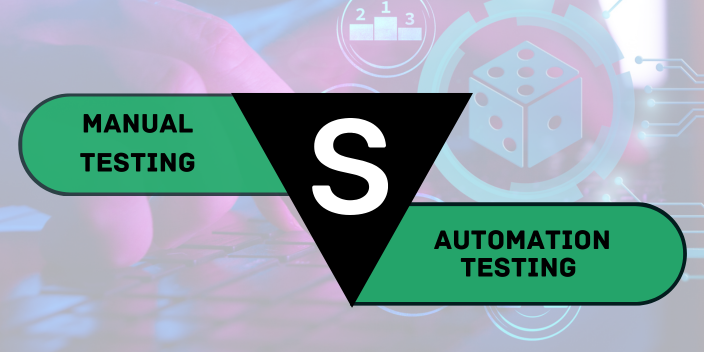In today’s Rapidly Changing digital landscape, software development has become an integral part of businesses across various industries. As Organisations strive to deliver high-quality products to their users, the question of testing methodologies arises. Manual Testing and automation Testing are two prominent approaches that play a crucial role in ensuring software reliability. In this article, we’ll delve into a comprehensive comparison of manual Testing and automated Testing, highlighting their differences, advantages, and best use cases. Before we go into deep Comparison, lets understand about software testing
What is Software Testing?
Software Testing is a Process used to identify the Correctness, Completeness and Quality of developed software. It includes the process of activities with the intent of finding errors in the software so that it can be corrected before the product is released to the end users. Software testing is a part of the software development life cycle, and it is a huge domain, but it is categorized as into two main categories i.e
- Manual Testing
- Automation Testing
Related Reading: Top Software Testing Trends To Watch Out For In 2023
What is Manual Testing?
Manual Testing is a software testing process in which the evaluation of a software application’s functionality, features, and performance is carried out manually by human testers without the use of automated testing tools or scripts. It involves a tester executing the application’s functionalities, interacting with the user interface, and verifying that it behaves as expected
What is Automation Testing?
Automated Testing is a method of testing software that involves using automation to validate its functionality and ensure that it meets the necessary requirements before being released for use. This technique allows testers to execute specific software tests much more quickly without relying on human testers. Automated Testing is beneficial for significant or repetitive test cases.Tools like Selenium Webdriver helps Automate testing Process
Related Blog : [ Automation Software Testing Tools ]
Comparing Manual and Automation Testing:
Let’s delve into a head-to-head comparison of these two testing approaches across various dimensions:
Accuracy and Reliability:
In manual Testing, the human tester’s judgement and intuition come into play, allowing for a deeper analysis of the software’s behavior. Automated Testing, while precise and consistent, might lack the context to identify specific subtle issues.

Efficiency and Time Savings:
Automated Testing trumps manual Testing in terms of speed and repeatability. Regression testing, for instance, can be executed rapidly with automation, enabling faster feedback loops during development.
Flexibility and Adaptability:
Manual Testing shines when adapting to dynamic changes, particularly in agile development environments. Automated Testing, although adaptable with effort, might struggle to keep pace with rapid changes.
Test Case Suitability:
While automated Testing is well-suited for repetitive and data-intensive test cases, manual Testing’s human insight is crucial for exploratory, usability, and ad-hoc Testing.
Cost Efficiency:
Budget considerations significantly impact testing strategies. Manual Testing tends to be more cost-effective in the short term, while automated Testing’s initial setup costs might be higher but can yield long-term savings through faster and more consistent Testing.
Time Savings:
Automated Testing is a time-saving champion, executing test cases swiftly and enabling quicker releases. Manual Testing’s thoroughness might require more time but can uncover critical defects that automation might miss.
Error Detection and Reporting:
Manual testers act as detectives, using their intuition to identify defects that might elude automated scripts. Automated Testing, however, excels in promptly reporting identified issues.
Test Case Suitability:
Choosing the proper testing approach hinges on the nature of the test case. Automated Testing shines when dealing with repetitive tasks, massive datasets, and extensive regression scenarios. Manual Testing’s adaptability is vital for exploratory and usability Testing, where a human’s intuitive understanding is invaluable.
Collaboration and Communication:
Manual Testing fosters collaboration within cross-functional teams. The dynamic interactions among team members help uncover issues that automated tests might not catch. Automated Testing, when integrated seamlessly, enhances communication by providing clear and consistent test results.
Agile Adaptability:
In agile environments, manual Testing’s flexibility proves beneficial. The ability to pivot quickly aligns with the iterative nature of agile development. Automated Testing can complement this approach by providing continuous integration and regression testing.
Conclusion:
Each approach brings unique advantages to the table, and the ideal choice depends on factors like project scope, timeline, and resource availability. Leveraging the strengths of manual and automation Testing in tandem can lead to a robust and reliable software development process. So, whether you opt for the human touch of manual Testing or the precision of automated Testing, make your decision based on a thorough understanding of your project’s needs. Ready to enhance your testing skills? Explore our comprehensive Software testing course in Chennai and take your software testing process to the next level.
FAQ’s
Can automation Testing completely replace manual Testing?
Automated Testing is efficient for repetitive tasks and regression testing, but manual Testing’s human judgement and exploratory approach uncover nuanced defects that automation might miss.
Is manual Testing more reliable than automation Testing?
Both manual and automation Testing have their strengths; manual Testing offers human judgement for complex scenarios, while automated Testing excels in repetitive validations.
How can organizations choose the right testing method?
Organizations should consider project scale, time constraints, and complexity when choosing between manual and automated testing methods.
What challenges do testers face with manual Testing?
Testers often face challenges of time consumption and subjectivity in manual Testing, requiring careful planning and execution.
Which industries benefit most from automated Testing?
Industries such as software development, e-commerce, finance, and healthcare benefit significantly from automated Testing due to their reliance on software systems and frequent updates.






